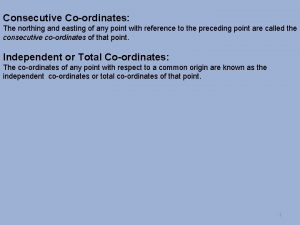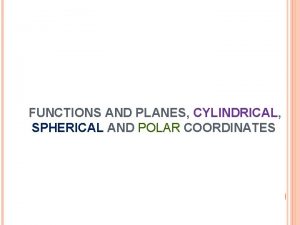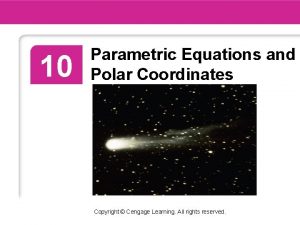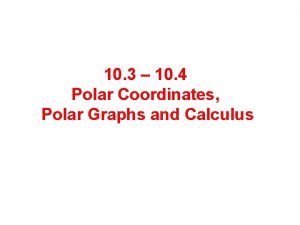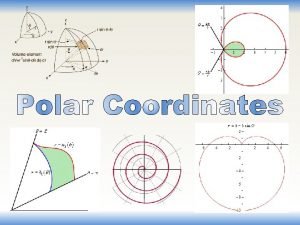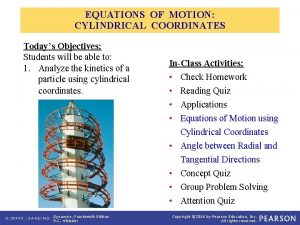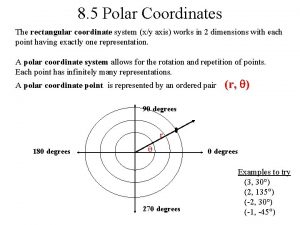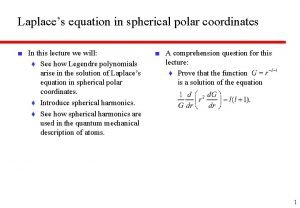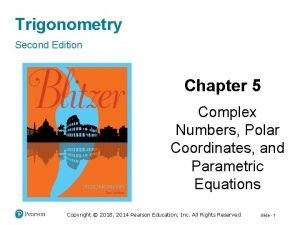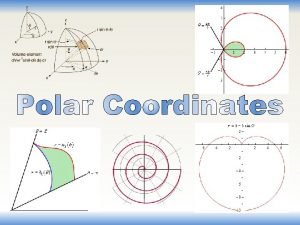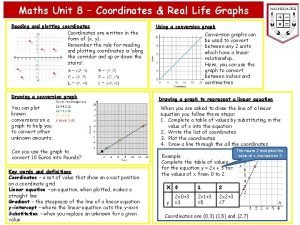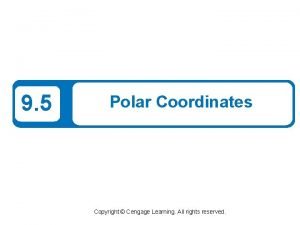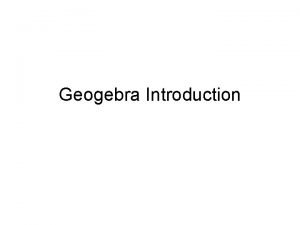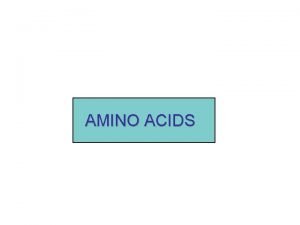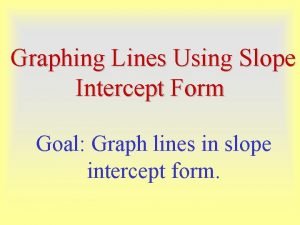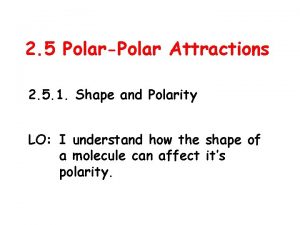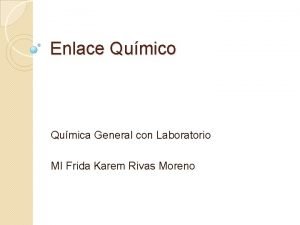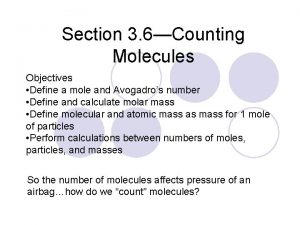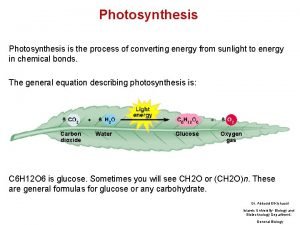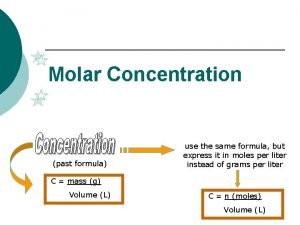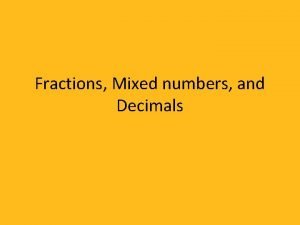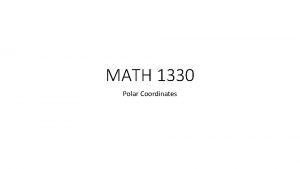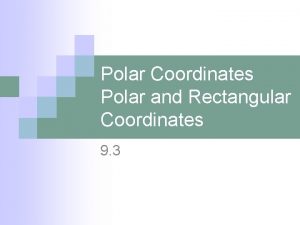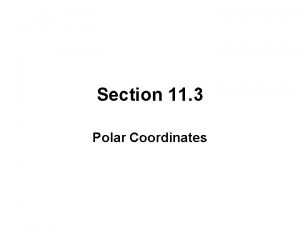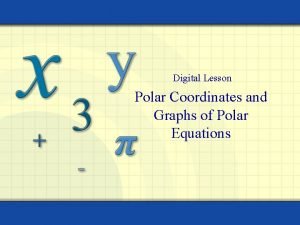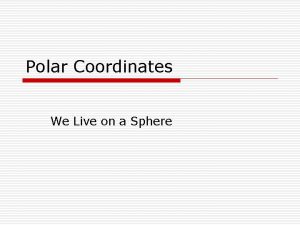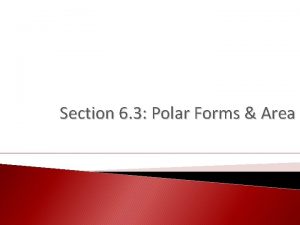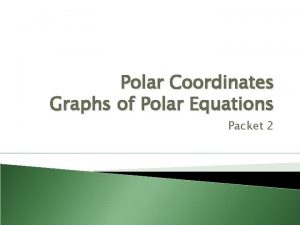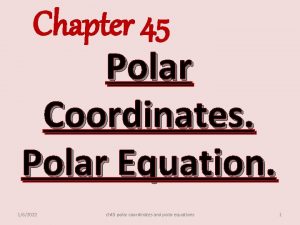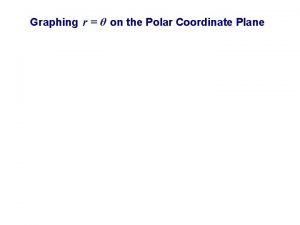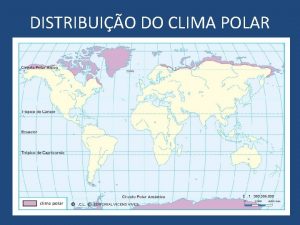Using Polar Coordinates Graphing and converting polar and


















































- Slides: 50

Using Polar Coordinates Graphing and converting polar and rectangular coordinates

B utterflies are among the most celebrated of all insects. It’s hard not to notice their beautiful colors and graceful flight. Their symmetry can be explored with trigonometric functions and a system for plotting points called the polar coordinate system. In many cases, polar coordinates are simpler and easier to use than rectangular coordinates.

You are familiar with plotting with a rectangular coordinate system. We are going to look at a new coordinate system called the polar coordinate system.

The center of the graph is called the pole. Angles are measured from the positive x axis. Points are represented by a radius and an angle radius (r, ) To plot the point First find the angle Then move out along the terminal side 5

The polar coordinate system is formed by fixing a point, O, which is the pole (or origin). The polar axis is the ray constructed from O. Each point P in the plane can be assigned polar coordinates (r, ). e c n ta P = (r, ) is d d cte e O r ir d = = directed angle Pole (Origin) Polar axis r is the directed distance from O to P. is the directed angle (counterclockwise) from the polar axis to OP. Copyright © by Houghton Mifflin Company, Inc. All rights reserved. 5

Graphing Polar Coordinates A The grid at the left is a polar grid. The typical angles of 30 o, 45 o, 90 o, … are shown on the graph along with circles of radius 1, 2, 3, 4, and 5 units. Points in polar form are given as (r, ) where r is the radius to the point and is the angle of the point. On one of your polar graphs, plot the point (3, 90 o)? The point on the graph labeled A is correct.

A negative angle would be measured clockwise like usual. To plot a point with a negative radius, find the terminal side of the angle but then measure from the pole in the negative direction of the terminal side.

Polar coordinates can also be given with the angle in degrees. 120 90 (8, 210°) 60 45 135 30 150 180 (6, -120°) 0 330 210 315 225 240 (-5, 300°) 300 270 (-3, 540°)

Graphing Polar Coordinates Now, try graphing A B C . Did you get point B? Polar points have a new aspect. A radius can be negative! A negative radius means to go in the exact opposite direction of the angle. To graph (-4, 240 o), find 240 o and move 4 units in the opposite direction. The opposite direction is always a 180 o difference. Point C is at (-4, 240 o). This point could also be labeled as (4, 60 o).

Graphing Polar Coordinates A B C How would you write point A with a negative radius? A correct answer would be (-3, 270 o) or (-3, -90 o). In fact, there an infinite number of ways to label a single polar point. Is (3, 450 o) the same point? Don’t forget, you can also use radian angles as well as angles in degrees. On your own, find at least 4 different polar coordinates for point B.

Plotting Points The point lies two units from the pole on the terminal side of the angle 1 2 3 0 3 units from the pole Copyright © by Houghton Mifflin Company, Inc. All rights reserved. 11

There are many ways to represent the point additional ways to represent the 1 2 3 0 point Copyright © by Houghton Mifflin Company, Inc. All rights reserved. 12

Let's plot the following points: Notice unlike in the rectangular coordinate system, there are many ways to list the same point.

Converting from Rectangular to Polar Find the polar form for the rectangular point (4, 3) r 4 3 To find the polar coordinate, we must calculate the radius and angle to the given point. We can use our knowledge of right triangle trigonometry to find the radius and angle. r 2 = 3 2 + 4 2 r 2 = 25 r=5 tan = ¾ = tan-1(¾) = 36. 87 o or 0. 64 rad The polar form of the rectangular point (4, 3) is (5, 36. 87 o)

Converting from Rectangular to Polar In general, the rectangular point (x, y) is converted to polar form (r, θ) by: 1. Finding the radius (x, y) r x y r 2 = x 2 + y 2 2. Finding the angle tan = y/x or = tan-1(y/x) Recall that some angles require the angle to be converted to the appropriate quadrant.

Converting from Rectangular to Polar On your own, find polar form for the point (-2, 3) r 2 = (-2)2 + 32 r 2 = 4 + 9 r 2 = 13 r= However, the angle must be in the second quadrant, so we add 180 o to the answer and get an angle of 123. 70 o. The polar form is ( , 123. 70 o)

Converting from Polar to Rectanglar Convert the polar point (4, 30 o) to rectangular coordinates. We are given the radius of 4 and angle of 30 o. Find the values of x and y. 4 30 o y Using trig to find the values of x and y, we know that cos = x/r or x = r cos . Also, sin = y/r or y = r sin . x The point in rectangular form is:

Converting from Polar to Rectanglar On your own, convert (3, 5π/3) to rectangular coordinates. We are given the radius of 3 and angle of 5π/3 or 300 o. Find the values of x and y. -60 o The point in rectangular form is:

The relationship between rectangular and polar coordinates is as follows. y The point (x, y) lies on a circle of radius r, therefore, r 2 = x 2 + y 2. (x, y) (r, ) r Definitions of trigonometric functions y Pole (Origin) x x Copyright © by Houghton Mifflin Company, Inc. All rights reserved. 19

Coordinate Conversion (Pythagorean Identity) Example: Convert the point into rectangular coordinates. Copyright © by Houghton Mifflin Company, Inc. All rights reserved. 20

Example: Convert the point (1, 1) into polar coordinates. Copyright © by Houghton Mifflin Company, Inc. All rights reserved. 21

Let's take a point in the rectangular coordinate system and convert it to the polar coordinate system. (3, 4) r 4 Based on the trig you know can you see how to find r and ? 3 r=5 We'll find in radians polar coordinates are: (5, 0. 93)

Let's generalize this to find formulas for converting from rectangular to polar coordinates. (x, y) r x y

Now let's go the other way, from polar to rectangular coordinates. Based on the trig you know can you see how to find x and y? 4 y x rectangular coordinates are:

Let's generalize the conversion from polar to rectangular coordinates. r y x

Convert the rectangular coordinate system equation to a polar coordinate system equation. Here each r unit is 1/2 and we went out 3 and did all angles. Before we do the conversion let's look at the graph. r must be 3 but there is no restriction on so consider all values.

Convert the rectangular coordinate system equation to a polar coordinate system equation. What are the polar conversions we found for x and y? substitute in for x and y We wouldn't recognize what this equation looked like in polar coordinates but looking at the rectangular equation we'd know it was a parabola.


When trying to figure out the graphs of polar equations we can convert them to rectangular equations particularly if we recognize the graph in rectangular coordinates. We could square both sides Now use our conversion: We recognize this as a circle with center at (0, 0) and a radius of 7. On polar graph paper it will centered at the origin and out 7

Let's try another: Take the tangent of both sides To graph on a polar plot we'd go to where and make a line. Now use our conversion: Multiply both sides by x We recognize this as a line with slope square root of 3.

Let's try another: Now use our conversion: We recognize this as a horizontal line 5 units below the origin (or on a polar plot below the pole)

Example: Convert the polar equation. into a rectangular Polar form Multiply each side by r. Substitute rectangular coordinates. Equation of a circle with center (0, 2) and radius of 2 Copyright © by Houghton Mifflin Company, Inc. All rights reserved. 32

Rectangular and Polar Equations in rectangular form use variables (x, y), while equations in polar form use variables (r, ) where is an angle. Converting from one form to another involves changing the variables from one form to the other. We have already used all of the conversions which are necessary. Converting Polar to Rectangular cos = x/r sin = y/r tan = y/x r 2 = x 2 + y 2 Converting Rectanglar to Polar x = r cos y = r sin x 2 + y 2 = r 2

Convert Rectangular Equations to Polar Equations The goal is to change all x’s and y’s to r’s and ’s. When possible, solve for r. Example 1: Convert x 2 + y 2 = 16 to polar form. Since x 2 + y 2 = r 2, substitute into the equation. r 2 = 16 Simplify. r=4 r = 4 is the equivalent polar equation to x 2 + y 2 = 16

Convert Rectangular Equations to Polar Equations Example 2: Convert y = 3 to polar form. Since y = r sin , substitute into the equation. r sin = 3 Solve for r when possible. r = 3 / sin r = 3 csc is the equivalent polar equation.

Convert Rectangular Equations to Polar Equations Example 3: Convert (x - 3)2 + (y + 3)2 = 18 to polar form. Square each binomial. x 2 – 6 x + 9 + y 2 + 6 y + 9 = 18 Since x 2 + y 2 = r 2, re-write and simplify by combining like terms. x 2 + y 2 – 6 x + 6 y = 0 Substitute r 2 for x 2 + y 2, r cos for x and r sin for y. r 2 – 6 rcos + 6 rsin = 0 Factor r as a common factor. r(r – 6 cos + 6 sin ) = 0 r = 0 or r – 6 cos + 6 sin = 0 Solve for r: r = 0 or r = 6 cos – 6 sin

Convert Polar Equations to Rectangular Equations The goal is to change all r’s and ’s to x’s and y’s. Example 1: Convert r = 4 to rectangular form. Since r 2 = x 2 + y 2, square both sides to get r 2 = 16 Substitute. x 2 + y 2 = 16 is the equivalent polar equation to r = 4

Convert Polar Equations to Rectangular Equations Example 2: Convert r = 5 cos to rectangular form. Multiply both sides by r r 2 = 5 r cos Substitute x for r cos r 2 = 5 x Substitute for r 2. x 2 + y 2 = 5 x is rectangular form.

Convert Polar Equations to Rectangular Equations Example 3: Convert r = 2 csc to rectangular form. Since csc ß = 1/sin , substitute for csc . Multiply both sides by 1/sin. Simplify y = 2 is rectangular form.

Polar Graphs You will notice that polar equations have graphs like the following:

Graphing Polar Equations on the TI -84 Hit the MODE key. Arrow down to where it says Func (short for "function" which is a bit misleading since they are all functions). Now, use the right arrow to choose Pol. Hit ENTER. (*It's easy to forget this step, but it's crucial: until you hit ENTER you have not actually selected Pol, even though it looks like you have!)

Graphing Polar Equations on the TI -84 The calculator is now in polar coordinates mode. To see what that means, try this. Hit the Y= key. Note that, instead of Y 1=, Y 2=, and so on, you now have r 1= and so on. In the r 1= slot, type 5 -5 sin(θ) Now hit the familiar X, T, θ, n key, and you get an unfamiliar result. In polar coordinates mode, this key gives you a θ instead of an X. Finally, close off the parentheses and hit GRAPH.

Graphing Polar Equations on the TI -84 If you did everything right, you just asked the calculator to graph the polar equation r=55 sin(θ). The result looks a bit like a valentine.

Graphing Polar Equations on the TI -84 The WINDOW options are a little different in this mode too. You can still specify X and Y ranges, which define the viewing screen. But you can also specify the θ values that the calculator begins and ends with.

Graphing Polar Equations on the TI -84 Graph r = 3 sin 2θ Enter the following window values: Θmin = 0 Xmin = -6 Ymin = -4 θmax = 2π Xmax = 6 Ymax = 4 Θstep = π/24 Xscl = 1 Yscl = 1

Examples a. Graph: r = 2 cos θ b. r = -2 cos θ c. r = 1 – 2 cos θ

Each polar graph below is called a Limaçon. 3 3 5 – 3 Copyright © by Houghton Mifflin Company, Inc. All rights reserved. 5 – 3 47

Each polar graph below is called a Lemniscate. 3 3 – 5 5 – 3 Copyright © by Houghton Mifflin Company, Inc. All rights reserved. 5 – 3 48

Each polar graph below is called a Rose curve. 3 3 a 5 – 5 a – 3 The graph will have n petals if n is odd, and 2 n petals if n is even. Copyright © by Houghton Mifflin Company, Inc. All rights reserved. 49

Function Gallery in your book on page 352 summarizes all of the polar graphs. You can graph these on your calculator. You'll need to change to polar mode and also you must be in radians. If you are in polar function mode when you hit your button to enter a graph you should see r 1 instead of y 1. Your variable button should now put in on TI-83's and it should be a menu choice in 85's & 86's.
 Cartesian to polar unit vectors
Cartesian to polar unit vectors Limit and continuity
Limit and continuity Independent coordinates in surveying
Independent coordinates in surveying Homogeneous coordinates vs cartesian coordinates
Homogeneous coordinates vs cartesian coordinates How do you convert polar to rectangular
How do you convert polar to rectangular Relation between spherical and cartesian coordinates
Relation between spherical and cartesian coordinates Parametric equations and polar coordinates
Parametric equations and polar coordinates 9-3 polar and rectangular forms of equations
9-3 polar and rectangular forms of equations Area between curve formula
Area between curve formula Convex limacon
Convex limacon Polar axis and pole
Polar axis and pole Polar equation art
Polar equation art Polar coordinate
Polar coordinate Geodesic polar coordinates
Geodesic polar coordinates Polar fourier series
Polar fourier series Equation of motion cylindrical coordinates
Equation of motion cylindrical coordinates Rectangular to polar form
Rectangular to polar form Polar coordinate symmetry
Polar coordinate symmetry Y=rsin
Y=rsin Conic sections in polar coordinates
Conic sections in polar coordinates Rectangular vs polar coordinates
Rectangular vs polar coordinates Double integrals in polar coordinates
Double integrals in polar coordinates Laplace equation in spherical polar coordinates
Laplace equation in spherical polar coordinates Conic section in polar coordinates
Conic section in polar coordinates How to find rectangular coordinates
How to find rectangular coordinates Polar formula
Polar formula Real life graphs
Real life graphs Multiple representations of polar coordinates
Multiple representations of polar coordinates Polar plot graph sheet
Polar plot graph sheet Geogebra matrices
Geogebra matrices Coordinate geometry
Coordinate geometry Electronegativity chart polar nonpolar
Electronegativity chart polar nonpolar Polar and non-polar amino acids
Polar and non-polar amino acids Polar and non polar dielectrics
Polar and non polar dielectrics Graphing lines in slope intercept form
Graphing lines in slope intercept form Graphing using intercepts
Graphing using intercepts Enlace polar
Enlace polar Polar attraction
Polar attraction Fqcolindres 2 eso
Fqcolindres 2 eso Percents to decimals
Percents to decimals Converting between percents decimals and fractions
Converting between percents decimals and fractions Moles to molecules
Moles to molecules Scan conversion in computer graphics
Scan conversion in computer graphics Photosynthesis is the process of converting
Photosynthesis is the process of converting Mass to grams conversion
Mass to grams conversion How to convert grams to moles
How to convert grams to moles Convert recurring decimal to fraction
Convert recurring decimal to fraction What is 75/4 as a mixed number
What is 75/4 as a mixed number It is a disease that prevents the body from converting
It is a disease that prevents the body from converting Prius plug in conversion
Prius plug in conversion Us customary units of capacity
Us customary units of capacity


